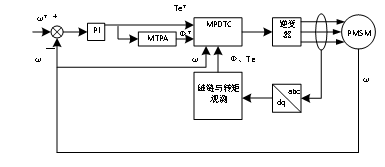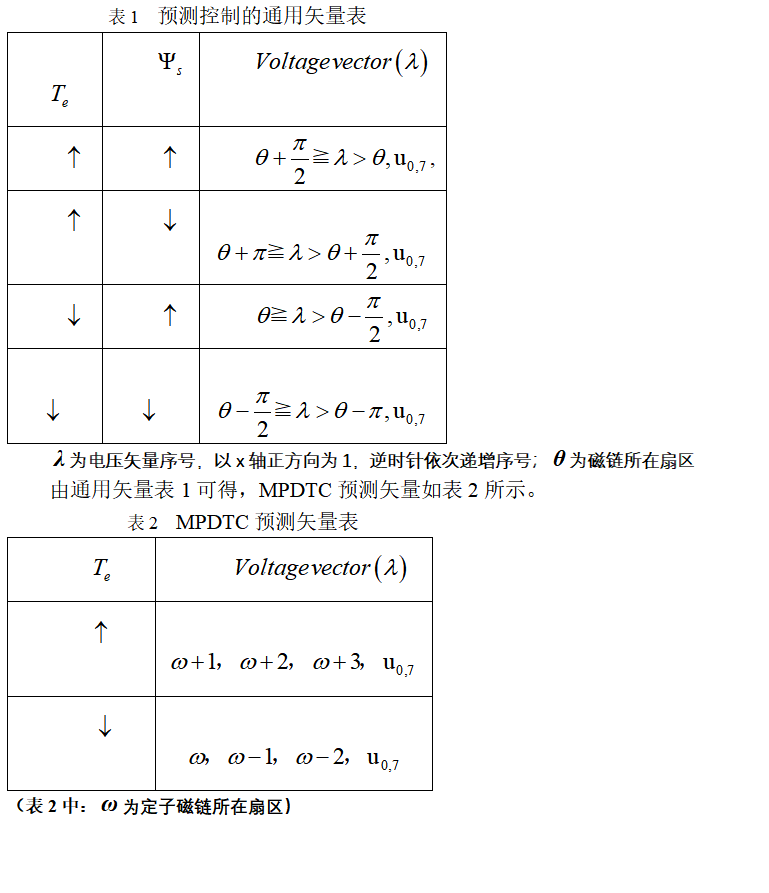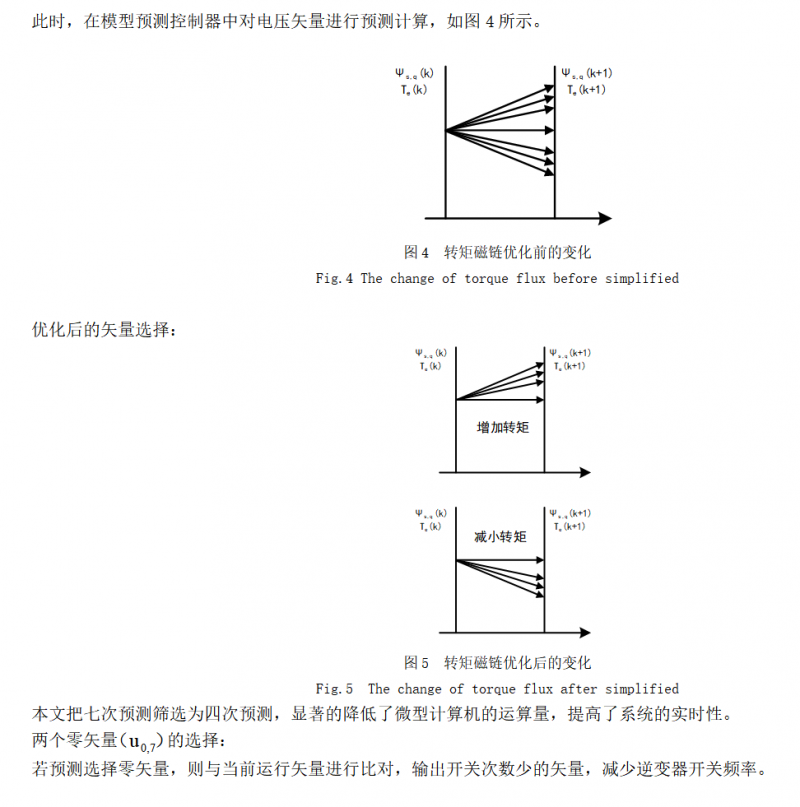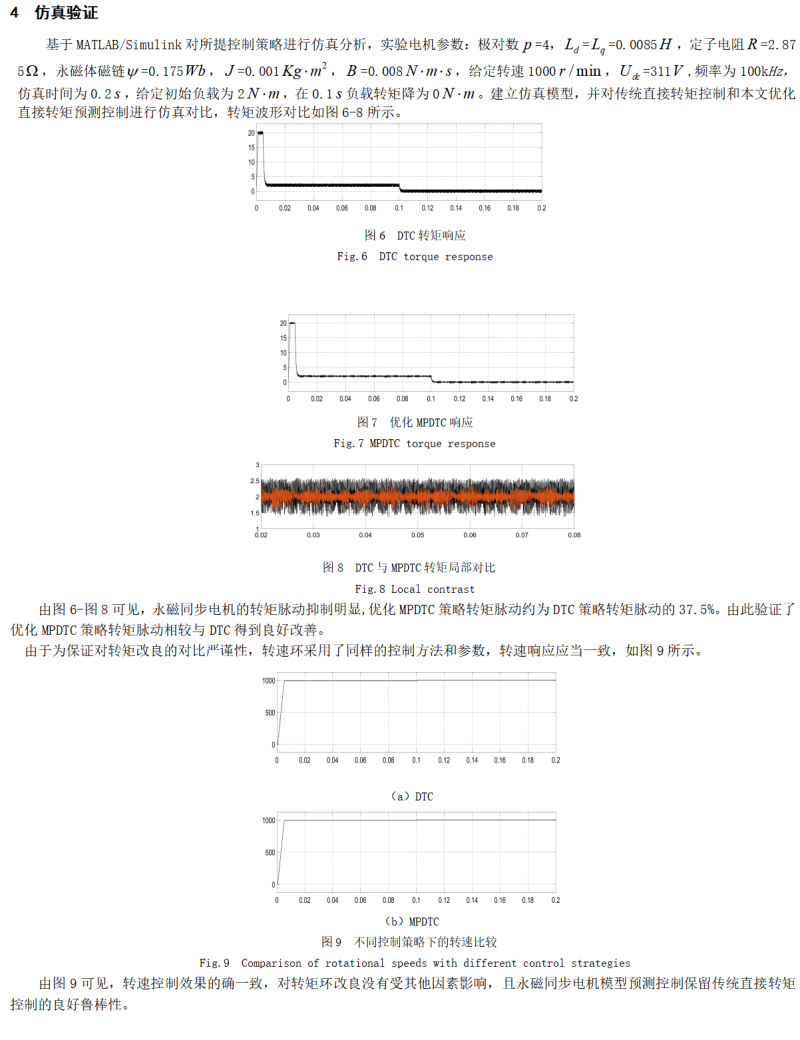关键词:模型预测控制;永磁同步电机;直接转矩控制;性能评估函数
Abstract: Because the traditional direct torque control uses a hysteresis controller, it will inevitably lead to large torque ripples. In this paper, a predictive algorithm is used instead of the hysteresis control for the torque loop and make improvements. First, a predictive control system model is established, the specific implementation process is optimized, and the prediction algorithm is optimized. At the same time, simulation comparison with direct torque control is performed. The results show that Compared with traditional direct torque control, it reduces the torque ripple more effectively and retains the good robustness of traditional direct torque control. And the proposed optimization model predicts that the direct torque control calculation amount is significantly greater than the model predictive torque control. Simulation proves the feasibility and effectiveness of the method.
Key words: Model predictive control; Permanent magnet synchronous machine; Direct torque control; Performance evaluation function
1 引言
永磁同步电机(Permanent Magnet Synchronous Motor,PMSM)因具有效率高、功率密度大、可靠性高等良好性能,成为近几年电机的研究热点,并且永磁电机在电动汽车、风电等诸多领域得到了广泛的需求和实际应用[1-2]。
模型预测控制(model predictive control,MPC)是一种基于预测控制的先进控制技术,具有较高的控制性能[3]。在电机控制领域范围内,一些学者将MPC誉为继磁场定向控制和直接转矩控制后的第三种高性能电机控制策略,因此 MPC 在电机控制领域获得了越来越多的关注[4-7]。同时,根据预测步数不同,MPC分为单步预测和多步预测。文献[8-9]提出一种适用于中高压大功率电机的多步预测MPC,该方法预测电机转矩和磁链在不同电压矢量作用下未来多个控制周期内的变化情况,并根据评估函数对各电压矢量的预测结果进行综合评估,最终确定一组最优电压矢量序列并输出序列首项。但是该方法运算量较大,一般性能的微处理器难以实现,目前应用还不多。而单步预测MPC只对未来一个控制周期内电机变量的变化进行预测计算,算法简单易行,便于实施,是当前的研究热点[10-11]。
本文主要使用单步预测转矩控制方法,以永磁同步电机为研究对象,首先,根据电机数学方程建立模型,并对转矩环进行改进,用模型预测控制代替bang-bang控制,之后提出预测控制通用矢量表,对模型预测控制算法进优化,计算量降低,提高系统实时性和降低对微计算机性能要求,并与直接转矩控制进行仿真对比,转矩脉动下降明显,验证本文所提方法的可行性和有效性。
2 直接转矩预测控制模型和系统

2.3 直接转矩预测控制系统
图2为永磁同步电机模型预测转矩控制系统结构图。
系统在每一采样周期测量电机电流和转速信号并计算定子磁链和转矩实际值,同时根据转速误差和MTPA控制策略获取转矩和定子磁链期望值。对于两电平的逆变器,根据系统变量实际值,模型预测转矩控制器对不同电压矢量作用下电机运行趋势进行7次预测然后进行延时补偿比较,通过性能指标评估函数对预测结果和系统变量期望值的误差进行评估,并选取综合误差最小的电压矢量进行输出。

图2 永磁同步电机模型预测转矩控制系统框图
3 模型预测转矩控制方法和优化
3.1 永磁同步电机预测控制流程
永磁同步电机预测控制流程如图3所示。

图3 永磁同步电机预测控制流程图
评估函数选择为:
![]()
3.2 电压矢量选择算法优化
对于两电平的逆变器,传统预测控制根据系统变量实际值,控制器对不同电压矢量作用下电机运行趋势进行7次预测,然后把七次预测结果带入评估函数中选出最优空间电压矢量输出。计算量较大,需要进行延时补偿。本文先进行一次筛选,之后把通过筛选的矢量再进行预测,节俭了相当一部分运算量,具体方法为:首先明确磁链增减根本条件为定子磁链在转子磁链方向分向量。转矩增减根本条件为定子磁链在转子交轴磁链方向有分向量,由此可定,本文提出预测控制的通用矢量如表1所示。
![]()


5 结论
采用本文所提的改进方法,较传统直接转矩控制的转矩脉动抑制效果明显,并且保持了传统直接转矩控制的快速动作性能,较模型预测转矩控制筛选了预测范围,优化了程序算法,显著降低了预测程序的运算量。
参考文献:
[1]EHASAN I M,GAO Y M,EMADI A.现代电动汽车、混合动力电动汽车和燃料电池车—基本原理、理论和设计[M]. 倪光正,倪培宏,熊素铭,译.北京:机械工业出版社,2012.
[2]夏长亮,阎彦.矩阵变换器-永磁同步电机系统[J]. 电工技术学报,2015,30(23):1-9.
[3]席裕庚,李德伟,林殊. 模型预测控制——现状与挑战[J].自动化学报,2013,39(3): 222.
[4]NIU Feng,WANG Bingsen, BABEL A S, et al. Comparative evaluation of direct torque control strategies for permanent magnet synchronous machines[J].IEEE Transactions on Power Electronics,2016,31(2):1408.
[5] RODRIGUEZ J, KENNEL R, ESPINOZA J, et al. High-performance control strategies for electrical drives: An experimental assessment[J]. IEEE Transactions on Industrial Electronics,2012,59(2): 812.
[6]RICHTERS, JONES C N,MORARI M. Computational complexity certification for realtime MPC with input constraints based on the fast gradient method[J].IEEE Transactions on Automatic Control,2012,57(6):2590.
[7]夏长亮,张天一,周湛清,等. 结合开关表的三电平逆变器永磁同步电机模型预测转矩控制[J].电工技术学报,2016,31(20):83.
[8]GEYER T,PAPAFOTIOU G,MORARI M. Model predictive direct torque control part I: concept, algorithm, and analysis[J].IEEE Transactions on Power Electronics,2009,56(6):1894.
[9] PAPAFOTIOU G, KLEY J,PAPADOPOULOS K G,et al. Model predictive direct torque control part Ⅱ:implementation and experimental evaluation[J]. IEEE Transactions on Industrial Electronics,2009,56(6):1906.
[10] 王永宾,林辉,计宏. 多约束永磁同步电机稳定模型预测控制策略[J].电机与控制学报,2011,15(12):7.
[11] NEMEC M,NEDELJKOVIC D,AMBROZIC V. Predictive torque control of induction machines using immediate flux control[J]. IEEE Transactions on Industrial Electronics,2007,54(4):2009.
作者简介:广开元(1995),男,籍贯辽宁,硕士研究生,研究方向为电机及其驱动控制。






共0条 [查看全部] 网友评论